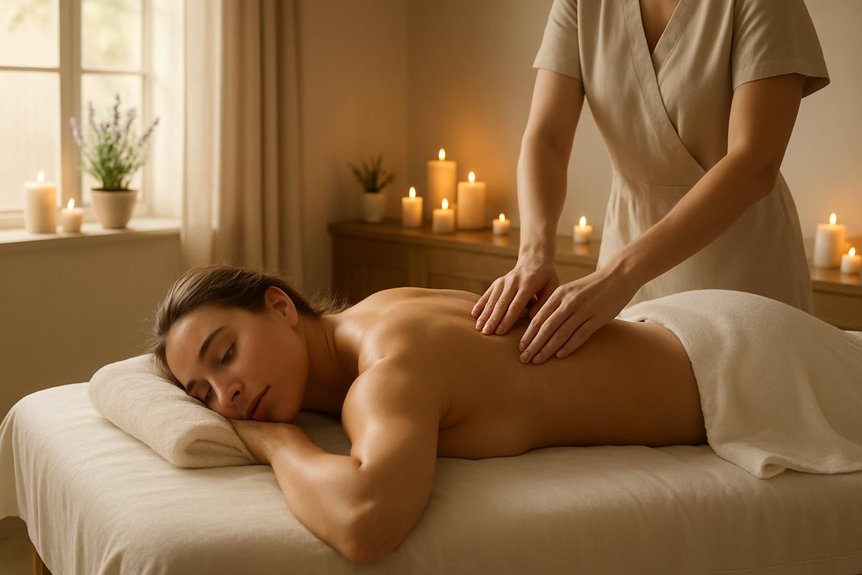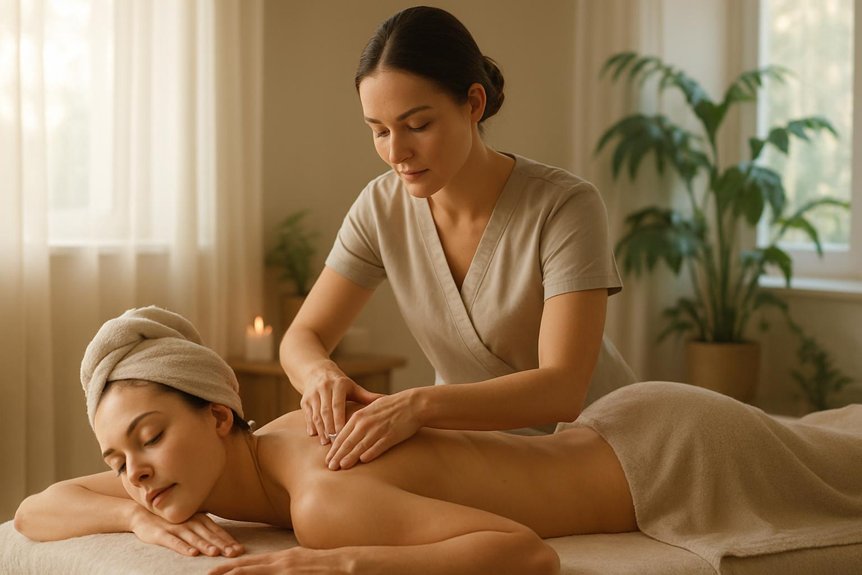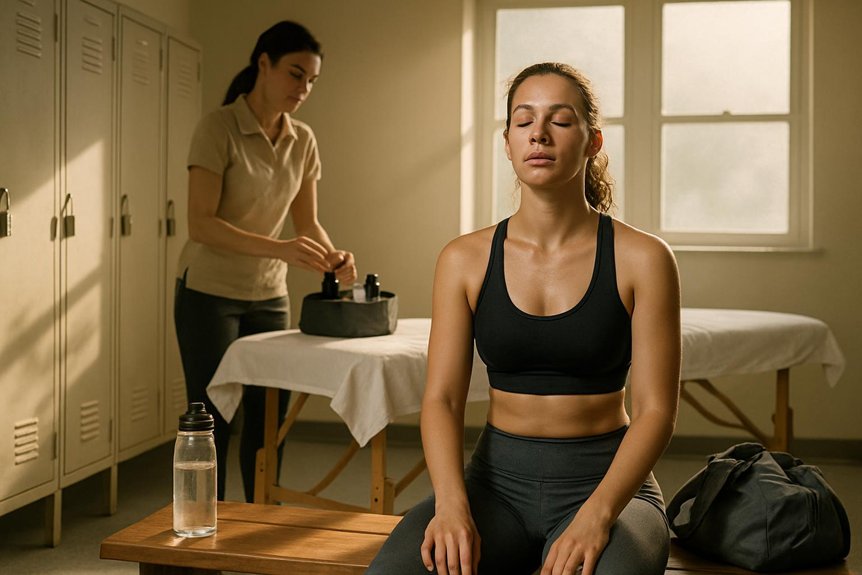Yes. Deep tissue massage often induces temporary fatigue. Slow, sustained pressure activates parasympathetic tone, lowering heart and respiratory rates and quieting cortical arousal. Targeted work on fascia and deep muscles (paraspinals, gluteals, calves) can leave tissues rehydrating and recalibrating for 24–48 hours. Mild soreness and stiffness are typical; sharp pain, swelling, numbness, or persistent exhaustion warrant medical advice. Hydration, gentle walking, diaphragmatic breathing, and nutrient-dense meals support recovery. Timing sessions away from intense workouts also helps. More ways to manage this follow.
Why Deep Tissue Massage Can Leave You Feeling Sleepy

A deep tissue massage can induce sleepiness because sustained, slow-pressure work on fascia and deeper muscle layers reduces sympathetic nervous system activity while enhancing parasympathetic tone. This shift lowers heart rate, eases respiratory rate, and quiets cortical arousal, inviting drowsiness.
Focused strokes along paraspinal muscles, gluteals, and calves release myofascial tension, decreasing nociceptive input and allowing the body to soften into rest.
At Spa & Massage clinics in London, therapists apply measured, patient pressure with informed pacing, encouraging diaphragmatic breathing to increase vagal influence.
Targeted work around the cervical extensors and suboccipitals often deepens a calm, eyes-heavy sensation. Hydrated tissues and improved local circulation further support warmth and comfort. Many clients welcome this tender, unhurried descent toward sleep as a sign their nervous system feels safe.
Similarly, therapies such as Reflexology can also promote a restorative state by stimulating specific points on the feet to enhance relaxation and healing throughout the body.
Normal Post-Massage Reactions vs. When to Be Concerned
After deep tissue work, transient fatigue, mild myalgia in treated muscle groups, lightheadedness, and increased thirst are common physiological responses to altered circulation and neuromuscular tone.
Red flags include sharp or escalating pain, focal swelling or bruising beyond expected tissue response, numbness or weakness following a specific nerve path, fever, chest pain, or shortness of breath—symptoms that warrant medical advice and contacting Spa & Massage for guidance.
Clients can self-monitor by tracking pain intensity, range of motion, sleep quality, and hydration over 24–48 hours.
Our therapists recommend gentle mobility, adequate fluids, and noting any symptoms that worsen or persist beyond two days.
Common Post-Massage Effects
Though responses vary by individual, several post-massage effects are expected and generally benign after deep tissue work. Transient fatigue is common as sympathetic tone drops and parasympathetic activity rises. Localised soreness may appear where adhesions were addressed—typically in the paraspinals, gluteals, calves, or forearms. Mild stiffness can follow as tissues rehydrate and recalibrate length–tension relationships.
Gentle emotional release may surface as protective muscle holding softens.
At Spa & Massage in London, therapists explain that these effects usually peak within 24–48 hours. Hydration, a warm shower, light walking, and unhurried breathing can reduce post-session heaviness. Many clients choose a lighter pressure finish and soothing oils to calm hypertonic areas.
Sleep quality often improves that night; occasional headache or thirst reflects circulatory change and typically resolves with rest and fluids.
Signs Needing Attention
Clear differentiation between expected responses and red flags helps clients manage recovery safely. After deep tissue work, it is typical to feel heaviness, transient fatigue, local soreness in targeted muscle groups, mild headache, and increased thirst for 24–48 hours.
Gentle ache along fascial lines, light skin erythema, and deeper sleep are also common.
Attention is warranted when pain escalates rather than softens, especially sharp, stabbing, or radiating pain; swelling, warmth, or bruising that spreads; numbness, tingling, or new weakness distal to the treated area; dizziness that persists beyond a few hours; shortness of breath; chest pain; or fever.
Persistent exhaustion beyond two days, dark urine, or severe cramps may indicate overloading.
At Spa & Massage, therapists encourage prompt contact about any of these signs and can adjust pressure, techniques, and session timing accordingly.
How to Self-Monitor
A simple self-check framework helps clients distinguish normal post–deep tissue responses from warning signs. In the first 24–48 hours, mild myofascial soreness, transient fatigue, and local warmth are expected as pressure redistributes fluid and metabolites within muscle compartments. Gentle mobility, hydration, and unhurried breaths usually soften these sensations.
Monitor three zones: intensity, spread, and function. Intensity should trend down daily; pain staying above 5/10 after day two warrants contact. Spread should remain near treated tissues; radiating numbness, tingling, or new swelling suggests neural or vascular irritation.
Function should improve—rising, turning the neck, or lifting should feel easier, not weaker.
At Spa & Massage, therapists advise light walking, magnesium-rich meals, and aware body scanning.
Persistent fever, calf swelling, chest pain, or dark urine needs urgent medical review.
How We Tailor Pressure to Support Your Energy Levels

At Spa & Massage, therapists determine ideal pressure by correlating client feedback with tissue response—monitoring muscle tone, skin temperature, and fascial glide to avoid excessive nociceptor stimulation that can trigger post-session fatigue.
Pace and depth are adjusted region by region: slower, deeper strokes for dense areas like the quadratus lumborum and gluteals; lighter, rhythmic work over the cervical extensors and intercostals to support autonomic balance.
This calibrated approach aims to release restriction while preserving energy, aligning technique with the client’s daily demands and recovery goals.
Finding Your Ideal Pressure
In each session, pressure is calibrated to the client’s nervous system and tissue response to prevent post-massage fatigue while maximising therapeutic effect.
At Spa & Massage, therapists assess tone in specific structures—paraspinals, quadratus lumborum, gluteus medius, calves, and forearm flexors—then modulate pressure to the threshold where tissue softens without triggering guarding.
They observe breath, skin flush, and fascial glide as objective feedback, inviting quiet check-ins (“lighter,” “hold,” “a touch more”).
Ideal pressure is the point where adhesions yield and circulation improves, yet the client remains parasympathetically anchored.
For those arriving depleted, our clinicians emphasise slower, measured compression and gentle cross-fibre work proximal to pain to avoid a stress response.
Warm oils reduce drag, enabling depth with less force, preserving energy while resolving tension.
Adjusting Pace and Depth
Because the nervous system sets the limit for therapeutic load, Spa & Massage therapists adjust stroke pace and depth in real time to support energy conservation while resolving dysfunction. Slow, sustained compressions down-regulate sympathetic drive, inviting parasympathetic ease; brisker strokes are reserved for well-tolerated tissues.
Depth targets are precise: superficial fascia first, then myofascial layers, and only then specific fibers within the erector spinae, quadratus lumborum, or gluteus medius as indicated.
They monitor breath, micro-guarding, and skin tone to calibrate pressure and cadence. When fatigue risk appears—cooler extremities, shallow breathing—they lengthen strokes and lighten load.
In London clinics, sessions blend deep work with integrative glides to clear metabolites, maintain venous return, and preserve post-session energy, reducing next-day heaviness.
What to Do After Your Session to Reduce Fatigue
Though deep tissue work often relieves myofascial tension, it can transiently tax the autonomic and lymphatic systems, so post‑session choices matter for reducing fatigue. Spa & Massage recommends gentle pacing for the next 12–24 hours: light walking to promote venous return, diaphragmatic breathing to rebalance vagal tone, and a warm—not hot—shower to encourage peripheral circulation without overstimulation.
Clients are advised to avoid strenuous lifting, high‑intensity intervals, and long static sitting that may re‑tighten paraspinals and hip flexors.
Our therapists suggest brief, targeted self‑care: a few minutes of supported spinal decompression, calf pumps for distal lymph flow, and slow neck rotations within pain‑free range. Comfortable layers keep musculature warm post‑treatment.
If unusual heaviness, headache, or dizziness persists beyond a day, contacting our clinic ensures tailored follow‑up.
Hydration, Nutrition, and Rest: Our Therapists’ Tips
While tissue remodeling and autonomic recalibration continue after deep tissue work, Spa & Massage therapists prioritize three pillars: fluids, fuel, and sleep.
Hydration supports plasma volume, lymphatic clearance, and fascial glide. They suggest 500–700 ml water in the first two hours post-session, then sipping regularly; adding electrolytes is helpful if sweating was significant.
For nutrition, they recommend a light, protein-forward meal within 1–2 hours—examples include eggs with leafy greens or tofu with quinoa—to supply amino acids for collagen turnover. Pair with complex carbohydrates for glycogen repletion and colorful plants for polyphenols. Caffeine and alcohol are minimized to avoid sleep and vasomotor disruption.
Rest anchors recovery. Clients are guided toward a quiet evening, gentle diaphragmatic breathing, warm bathing, and 7–9 hours of unbroken sleep to consolidate neuromuscular recalibration.
Timing Your Massage Around Workouts and Busy Days

Planning deep tissue work relative to training and demanding schedules reduces fatigue risk and improves outcomes. Spa & Massage advises booking intense work 24–48 hours after heavy lifting or endurance sessions, when microtears and delayed onset muscle soreness are most active. This timing allows targeted pressure along myofascial lines, restoring glide in quadriceps, hamstrings, calves, and paraspinals without compounding load.
Before key workouts or events, lighter pressure or a sports massage focus—compressions, mobilisations, and assisted stretching—primes neuromuscular readiness without excessive parasympathetic drop.
For busy days, midday or early evening sessions permit gentle post-treatment movement, hydration, and a protein-rich meal to support tissue repair.
Clients often benefit from a consistent rhythm: training day, recovery day, then deep tissue. Our therapists personalise cadence to cycle phase, work demands, and sleep patterns.
Who Might Feel More Tired and How We Adjust in Our Clinics
Because recovery responses vary, certain clients are more prone to post–deep tissue tiredness, including those with high training loads, acute or subacute DOMS, low sleep duration, elevated psychosocial stress, iron or B12 deficiency risk, first-time recipients of deep pressure, and individuals with dysautonomia or hypotension tendencies.
At Spa & Massage in London, therapists screen for these factors, then modulate depth, cadence, and duration. They pace sequences to respect autonomic tone, use slower effleurage between focused petrissage, and avoid prolonged ischemic compression when tissues are irritable.
Positioning is adjusted to prevent orthostatic dips, with gradual transitions off the couch. Hydration guidance and gentle diaphragmatic breathing are offered.
For sensitive clients, shorter sessions, lighter lubricant application, and spaced follow-ups maintain therapeutic load while minimising fatigue.
Conclusion
Like a well-tuned orchestra settling after a crescendo, the body—fascia, muscle spindles, and autonomic nerves—returns to a calmer tempo post-treatment. Fatigue signals parasympathetic dominance, metabolic byproduct clearance, and micro-repair beginning their quiet work. Listened to, it restores; ignored, it lingers. Clients who hydrate, refuel, and pace activity convert heaviness into steadier energy. Therapists who calibrate depth, tempo, and intent help the score resolve cleanly. In that measured decrescendo, relief and resilience meet—evidence guiding practice, comfort guiding pace.